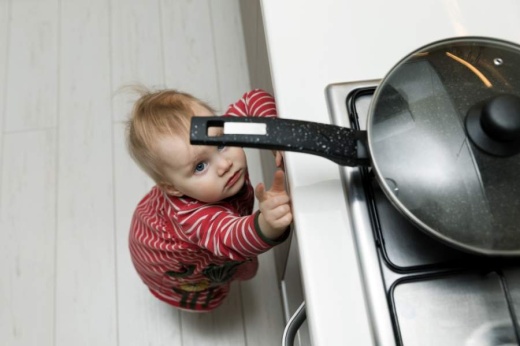“We’re all in that boat and feeling that pressure,” Abbe said. “You can make safe spaces for them that you’ve childproofed the area so that you feel confident you can leave them while you’re maybe on your laptop or in a meeting.”
Taking regular breaks for children to go outside and let their energy out will also help avoid restless energy and injuries, Abbe said.
A third of traumatic injuries happen in the home, Abbe said, and are the leading cause of death among children.
“Because we're spending so much time at home and because we might be having those distractions from work and just being tired and stressed out ourselves, that's why knowing these areas where the injuries occur are really important so that you can childproof as much as possible,” Abbe said.
Some of the top areas of injury for kids include falling, poisoning, drowning and burning, according to Abbe. Younger children are more likely to suffer from poisoning or downing, while older, more active children tend to sustain fall injuries.
Falls are the No. 1 traumatic injury children suffer and bring children into the hospital, according to Abbe. Placing locks on second-story windows can help protect children, as well as being aware that children cannot lean on window screens.
To avoid poisoning, Abbe recommends viewing the world from the perspective of a child. Crawling on the floor can give parents a new viewpoint on what might be accessible. This can include chemicals, medicine and even makeup, she said.
If a child does ingest something dangerous, the first step is to call poison control. Parents can receive expert information faster than if 911 is dialed first, according to Abbe.
Drownings can be avoided in the bathtub by preparing every step of the bath before placing a child in the water. Having towels and clothes nearby prevents a parent from leaving the room for any reason, Abbe said.
Those with pools should maintain constant supervision when their child is outside and should be within arm’s reach of a younger child in a pool. Roughly 60% of drownings in North Texas occur when an adult is nearby, Abbe said.
To avoid burns, parents can turn the handle of pots and pans inward so children cannot reach up and pull them down, Abbe said. Pots can also be placed on the back burner rather than at the front of the stove.
Another important safety lesson for children going outside for exercise during the pandemic is pedestrian safety, according to Abbe. Crossing the street requires practice, and teaching kids to look left, right and then left again is key, she said.
Children must also learn to make eye contact with drivers before crossing the street, Abbe said. This will help to avoid accidents with distracted drivers.
Lastly, children who bike, roller blade, scooter or skateboard should wear a helmet at all times.
“It is the main way that we're able to keep them from having the traumatic brain injuries,” Abbe said. “If you're going to go with him on the bike, we need to be good role models as parents and wear our own helmet as well, because kids do look up and model our behavior.”
The more parents are aware of danger areas in and around their homes, the more they can protect from injuries, Abbe said.
“It's important for us to know what are the danger hotspot areas in the home so that we can guard against those,” Abbe said.
More resources on childproofing homes and protecting children against traumatic injuries can be found on the Children’s Health website.





